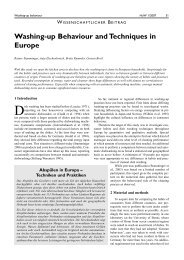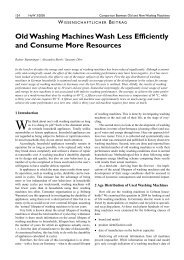Development of a novel mechatronic system for mechanical weed ...
Development of a novel mechatronic system for mechanical weed ...
Development of a novel mechatronic system for mechanical weed ...
You also want an ePaper? Increase the reach of your titles
YUMPU automatically turns print PDFs into web optimized ePapers that Google loves.
Introduction<br />
limited and environmentally friendly cleaning agents need to be used in organic<br />
farming. Because <strong>of</strong> that, input <strong>of</strong> such toxic substances, so called xenobiotics,<br />
to aquatic eco<strong>system</strong>s can be neglected. Also, organic farms usually have low<br />
external N-fertiliser input, because synthetic N-fertilisers are restricted and<br />
import <strong>of</strong> fodder and manure is limited. The use <strong>of</strong> raw phosphates instead <strong>of</strong><br />
highly soluble phosphates which are not allowed directly influences the lower<br />
total P-fertiliser input. According to the limitations, it is obvious that risks in N-<br />
and P-leaching on organic farms are generally smaller. Considering risk<br />
assessment and outputs generated by organic farming, significant positive<br />
influence on water protection can be realised (Paulsen et al. 2002).<br />
In organic farming, <strong>weed</strong>s are the most significant production problem (Stopes<br />
and Millington 1991; Beveridge and Naylor 1999; Walz 1999; Zinati 2002) and<br />
sometimes total crop losses from <strong>weed</strong>s can occur. One research <strong>of</strong> the relative<br />
frequency <strong>of</strong> <strong>weed</strong>s in the period <strong>of</strong> three years after conversion to organic<br />
farming showed that the total number <strong>of</strong> <strong>weed</strong> seeds in the soil had increased<br />
more than three times from 4,050 m -2 to 17,320 m -2 (Albrecht 2005). Similar<br />
research in areas with different levels <strong>of</strong> fertility showed an increase in viable<br />
<strong>weed</strong> seed numbers ranging from 54-495% at the end <strong>of</strong> one crop rotation<br />
(Turner 2005). Hence, it is obvious that <strong>weed</strong> control in organic farming could<br />
be designated as the most serious task which needs to be solved by means <strong>of</strong><br />
automation. This fact is confirmed by most research works and by farmers<br />
directly involved in production (Yarham and Turner 1992).<br />
While in 1985 the EU had 100,310 ha <strong>of</strong> organic farmland, that number<br />
increased up to 1,462,349 ha in 1995, 5,904,481 in 2003 and 6,115,465 in 2005<br />
(EUROSTAT 2007). As high as the numbers may be, the increasing trends in<br />
organic farmland area and pesticide use have levelled <strong>of</strong>f over the past five<br />
years. The average annual growth rate <strong>of</strong> certified and policy-supported organic<br />
and in-conversion land in the period from 1988-98 was 34%, while from 1993-<br />
98 the annual rate had lowered to an average <strong>of</strong> 28%. However, in the period<br />
2002-03 organic farmland grew by only 5.4% and estimates <strong>of</strong> growth <strong>for</strong> 2003-<br />
04 are only about 3.0% (Lampkin 2003). In the same time pesticide<br />
consumption has also stopped growing.<br />
8





